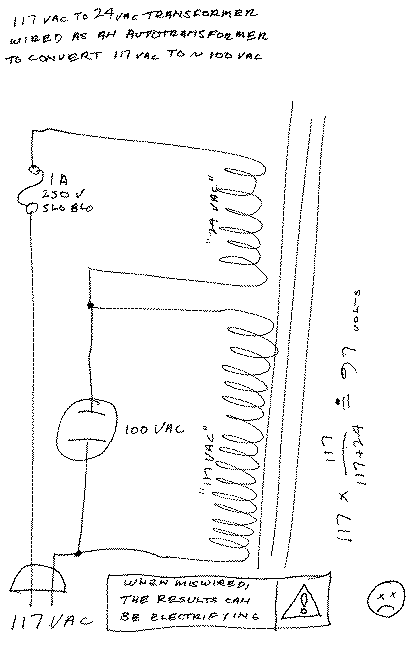``Cheap'' AC Power Conversion from
120 to 100 Volts AC
-An anonymous, conservative, engineer
Someone mentioned wiring a 24vac transformer (such as a doorbell
transformer, or electronics store power supply transformer) as an
autotransformer to drop USA voltage (117V nominal) to near Japanese
voltage (100V nominal). After I saw this sentence I realized how
easily somebody could endanger human life doing this carelessly and
how wordy it would be to give complete directions. These are the most
obvious dangers:
- Lifting the ground: USA power has a neutral
(grounded, sort of) lead for one wire. If
If the autotransformer is wired improperly,
neutral will rise many volts above true
ground, and any ground loop problems will
become "line powered," meaning they can make
smoke and fire as well as melted MD devices.
- Boosting rather than dropping the voltage:
possible smoke and fire, probable melted MD
devices.
- Painful or lethal electric shock because the
connections are inadequately or improperly
insulated from human or animal contact.
This being said, the project can be started on a breadboard,
hence the term "breadboard circuit". You will
be working with a high-energy source -- the power line
-- which can electrocute you almost as easily as not,
and doesn't care one whit that you are too nice a
person to die so young.
Directions

Parts List
- 117 VAC -> 24 VAC doorbell or power supply transformer
- Fuse holder with 250 VAC, 1 Amp slow blow fuse
- AC line cord, with AC plug attached
- AC receptacle
- Breadboard (Do not use a wood
breadboard, this can conduct electricity and kill you.
Some ceramic breadboards are also conductive, and some
plastic breadboards are flammable. Formica or Micarta
are good electronic "breadboard" surfaces.)
Assembly Instructions
- Be certain that you are working in an appropriate
work space with adequate light, heat, ventilation,
and an electrical power source suitable for
developing power-line devices, including GFCI,
proper polarity and grounding. Comply with OSHA
and obtain all necessary permits &c to do the work.
- Connect the 117vac neutral (grounded, sort of)
lead to one 117vac lead. The neutral is on
the wide spade of the plug, on the striped
side of the zip cord, as long as they are
not miswired (altogether too common).
- Connect the 117vac hot wire to a 1amp 250vac
slow blow fuse.
- Connect one 24vac lead to the other side of
the fuse.
- Connect the neutral of a receptacle (the
thing you plug a wall wart in to) to the
neutral connection at the 117vac transformer
input. (This is the connection made in #1.)
- Connect the hot of the receptacle to the
remaining 24vac lead and the remaining
117vac transformer lead.
- If the 24vac winding is center-tapped (not
common in doorbell transformers, but quite
common in power supply transformers), make
no connection to the center-tap lead.
- Make certain all the connections are mechanically
solid, electrically conductive, and insulated
from human contact.
- Plug in the 117vac and read the output at
the receptacle with a voltmeter. It will
be either less than the (nominal 117vac)
input voltage, about 100vac, or more than
the (nominal 117vac) input voltage, about
140vac. (Note that US nominal 117vac can be as low as 105vac or
up to 125vac for 90%+ of customers, worse during brown-outs and
surges).
- If it reads about 140vac, reverse the 24vac
wires and try again; it should read about
100vac this time.
- Perform electrical leakage testing, heating
factor, maximum permissible current
measurements and calculations; prepare
standard engineering worksheets to
document compliance with all the standards.
- Package it neatly in a proper enclosure,
comply with all the provisions of the
National Electrical Code, and submit it
to Underwriters Laboratories for
certification.
- After you have all your government approvals
you can use it to your heart's content.
- Obtain product liability insurance, design
proper shipping containers, write a Users
Manual to protect the innocent, sell a
million of them, move in next door to Bill
Gates, and write articles about "Barriers to
Entry."
Perhaps this is too much for the technical
ability of the average MDer, although it is not
much of a trick for any electrically oriented
techie.
What's missing here is a discussion of
checking the wall socket for proper wiring and
a discussion of the comparative benefits of a three-
wire grounded implementation vs a doubly insulated
two-wire version; maybe somebody else will contribute
them.
There are many additional concerns that all we who have been
designing have worked around forever, but which may be entirely novel
concepts to newbies. I remain anonymous in this article because I
want nothing to do with putting a loaded gun in the hands of an MD
fancier. At the same time, this can be the answer to 100vac for about
the cost of a cheap MiniDisc, and may make a big difference. There
have been times in my life when knowing how to get by cheaply has made
the difference, and I don't want to hold back information that might
help others any more than I want to lead them recklessly into danger.

